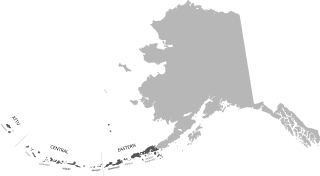Related Research Articles

The glottal stop or glottal plosive is a type of consonantal sound used in many spoken languages, produced by obstructing airflow in the vocal tract or, more precisely, the glottis. The symbol in the International Phonetic Alphabet that represents this sound is ⟨ʔ⟩.

Aleut or Unangam Tunuu is the language spoken by the Aleut living in the Aleutian Islands, Pribilof Islands, Commander Islands, and the Alaska Peninsula. Aleut is the sole language in the Aleut branch of the Eskimo–Aleut language family. The Aleut language consists of three dialects, including Unalaska, Atka/Atkan, and Attu/Attuan.

Wyandot is the Iroquoian language traditionally spoken by the people known as Wyandot or Wyandotte, descended from the Tionontati. It is considered a sister to the Wendat language, spoken by descendants of the Huron-Wendat Confederacy. It was last spoken, before its revival, by members located primarily in Oklahoma, United States, and Quebec, Canada. Linguists have traditionally considered Wyandot as a dialect or modern form of Wendat.
A.tong is one of the Garo dialect Sino-Tibetan language which is also related to Koch, Rabha, Bodo other than Garo language. It is spoken in the South Garo Hills and West Khasi Hills districts of Meghalaya state in Northeast India, southern Kamrup district in Assam, and adjacent areas in Bangladesh. The spelling "A.tong" is based on the way the speakers themselves pronounce the name of their language. There is no glottal stop in the name and it is not a tonal language.
Since the early 16th century, Nahuatl has been written in an orthography in Latin script based on Spanish spelling conventions, with overall the same values for letters in both orthographies. Over the centuries, Latin script was utilized to record a large body of Nahuatl prose and poetry, which somewhat mitigated the devastating loss of the thousands of Aztec manuscripts that were burned by Spanish missionaries.

The Mandinka language, or Mandingo, is a Mande language spoken by the Mandinka people of Guinea, northern Guinea-Bissau, the Casamance region of Senegal, and in The Gambia where it is one of the principal languages.

The Luiseño language is a Uto-Aztecan language of California spoken by the Luiseño, a Native American people who at the time of first contact with the Spanish in the 16th century inhabited the coastal area of southern California, ranging 50 miles (80 km) from the southern part of Los Angeles County, California, to the northern part of San Diego County, California, and inland 30 miles (48 km). The people are called "Luiseño", owing to their proximity to the Mission San Luis Rey de Francia.

Caddo is a Native American language, the traditional language of the Caddo Nation. It is critically endangered, with no exclusively Caddo-speaking community and as of 2023 only two speakers who had acquired the language as children outside school instruction, down from 25 speakers in 1997. Caddo has several mutually intelligible dialects. The most commonly used dialects are Hasinai and Hainai; others include Kadohadacho, Natchitoches and Yatasi.
The Karkar language, also known as Yuri, is the sole Eastern Pauwasi language of Papua New Guinea. There are about a thousand speakers along the Indonesian border spoken in Green River Rural LLG, Sandaun Province.
The phonological system of the Hawaiian language is based on documentation from those who developed the Hawaiian alphabet during the 1820s as well as scholarly research conducted by lexicographers and linguists from 1949 to present.
Bukawa is an Austronesian language of Papua New Guinea.
Kara is an Austronesian language spoken by about 5,000 people in 1998 in the Kavieng District of New Ireland Province, Papua New Guinea.
Tifal is an Ok language spoken in Papua New Guinea. Dialects are Tifal (Tifalmin), Urap (Urapmin) and Atbal (Atbalmin).

Kaluli is a language spoken in Papua New Guinea. It is a developing language with 3,100 speakers. Some people refer to this language as Bosavi, however the people themselves refer to the language as Kaluli. There are four dialects, Ologo, Kaluli, Walulu, and Kugenesi. The differences between the dialects are not clear. Their writing system uses the Latin script. Kaluli belongs to the Trans-New Guinea language family. Kaluli was first analyzed by Murray Rule in 1964 who wrote a preliminary phonological and morphological analysis. A dictionary of Kaluli has been compiled by Schieffelin and Feld (1998).
Kensiu (Kensiw) is an Austro-asiatic language of the Jahaic subbranch. It is spoken by a small community of 300 in Yala Province in southern Thailand and also reportedly by a community of approximately 300 speakers in Western Malaysia in Perak and Kedah states. Speakers of this language are Negritos who are known as the Mani people or Maniq of Thailand.
Gimi (Labogai) is a Papuan language spoken in Eastern Highlands Province, Papua New Guinea.
Kwoma is a Sepik language of Papua New Guinea also known as Washkuk. The word 'Kwoma' means "hill people". Washkuk is a government name for the people of Kwoma. Linguists have the given the name 'Kwoma' as the primary name of the language, but 'Nukuma' is the specific name for the Northern dialect. Nukuma means people who live along the upper reaches of the Sanchi River. The speakers of Kwoma are located in the Ambunti district of the Sepik River region. There are two dialects known as Kwoma (Washkuk) and Nukuma. The Kwoma dialect or "hill people" is located in the Washkuk Hills which is a range of mountains on the north side of the Sepik. The Nukuma dialect or "headwater people" live to the north and west of the Washkuk range along the Sepik River. Kwoma is considered an endangered language with an estimated 2,925 native speakers worldwide.

The Bukid language, Binukid or Bukidnon, is an Austronesian language spoken by indigenous peoples of Northern Mindanao in the southern Philippines. The word Bukid means 'mountain' or 'highland' while Binukid means 'in the manner, or style, of the mountain or highland'. In Bukidnon province, it is referred to as Higaonon.
Bunama is an Austronesian language spoken in the D'Entrecasteaux Islands of Papua New Guinea.

Ilocano is an Austronesian language spoken in the Philippines, primarily by Ilocano people and as a lingua franca by the Igorot people and also by the native settlers of Cagayan Valley. It is the third most-spoken native language in the country.
References
- 1 2 Alekano at Ethnologue (25th ed., 2022)

- ↑ Deibler, Ellis W. 1987. "The function of glottal stop in Gahuku." In John M. Clifton (ed.), Studies in Melanesian orthographies, 23-30. Data Papers on Papua New Guinea Languages, 33. Ukarumpa: Summer Institute of Linguistics. Archived 2012-10-15 at the Wayback Machine
- 1 2 Deibler, Ellis W., compiler. Available: 2008; Created: 2008. Dictionaries of Alekano - English and English - Alekano. [Manuscript] iii, 311 p. Archived 2012-10-15 at the Wayback Machine
- 1 2 1992. Alekano Organised Phonology Data. [Manuscript] Archived 2012-10-15 at the Wayback Machine
- ↑ "WALS Online - Language Gahuku". Archived from the original on 2011-07-04. Retrieved 2011-04-11.